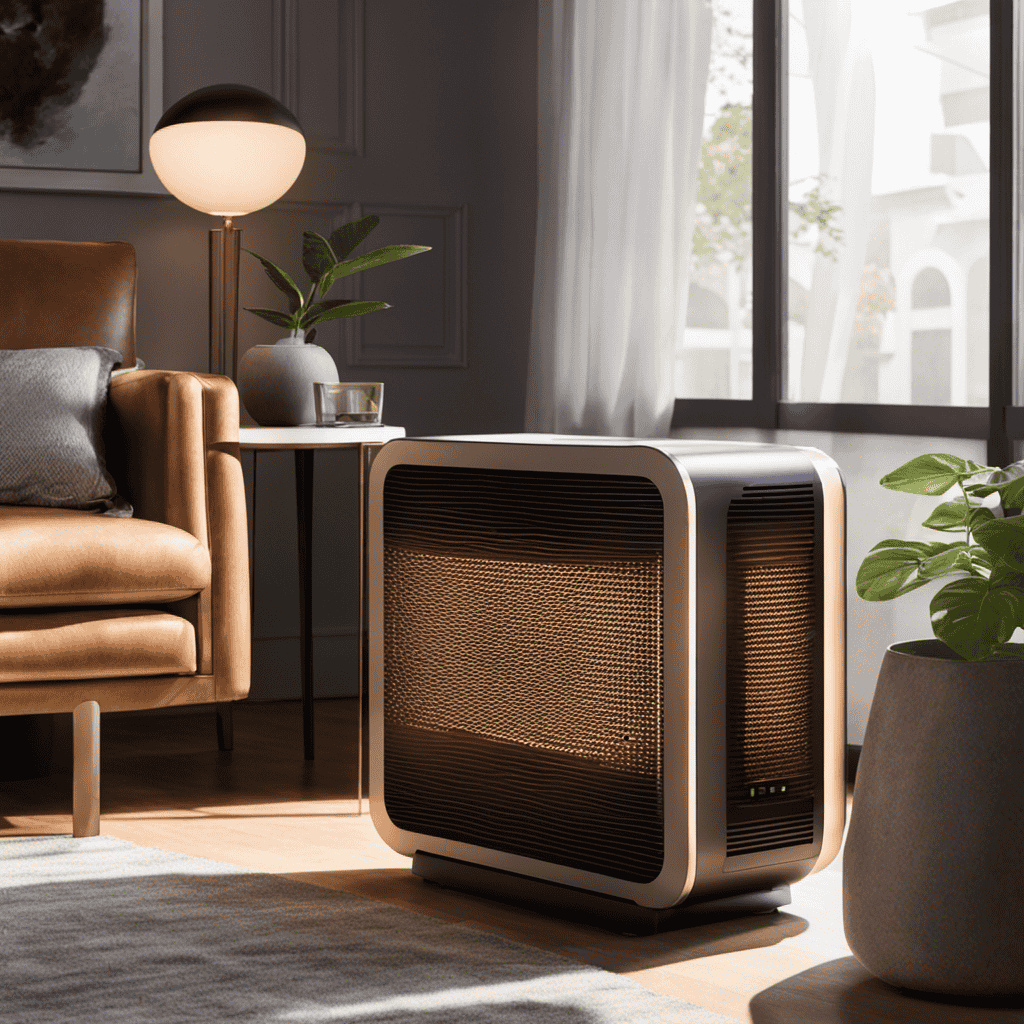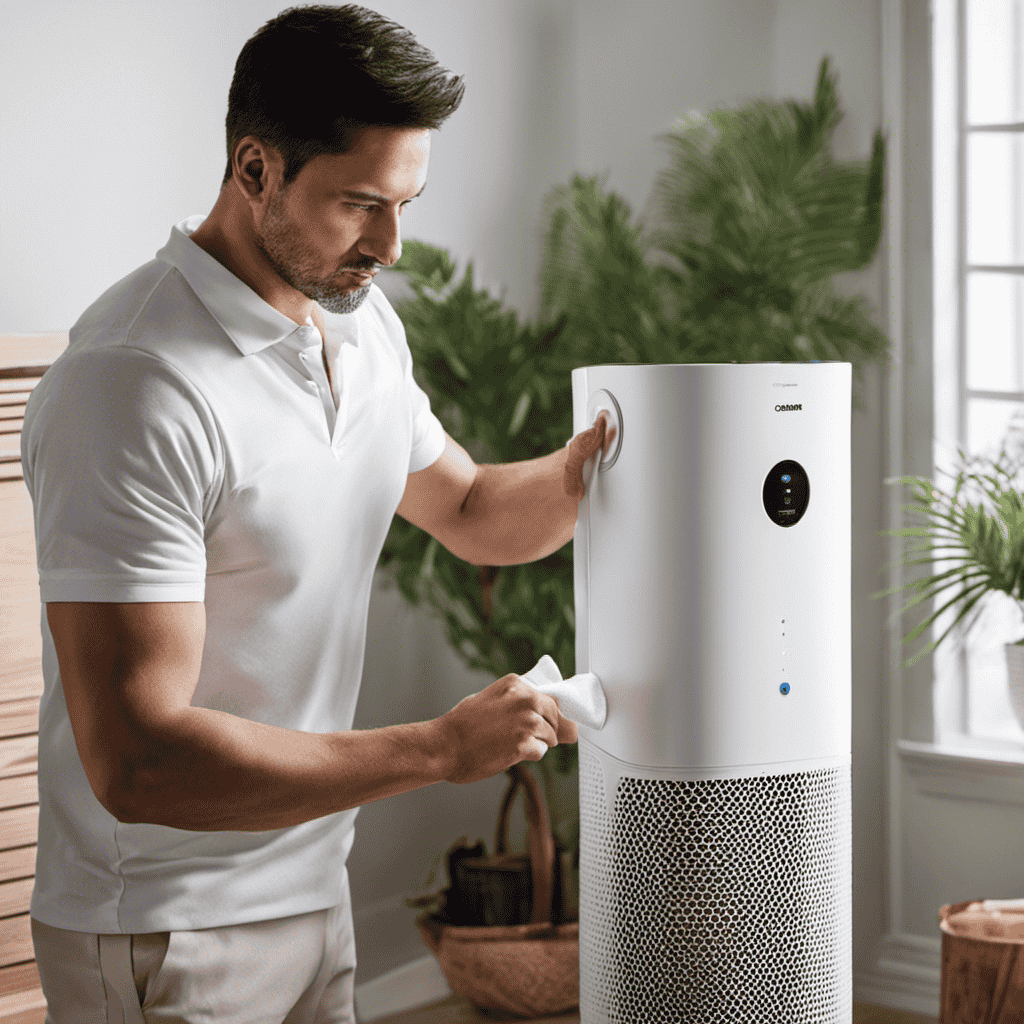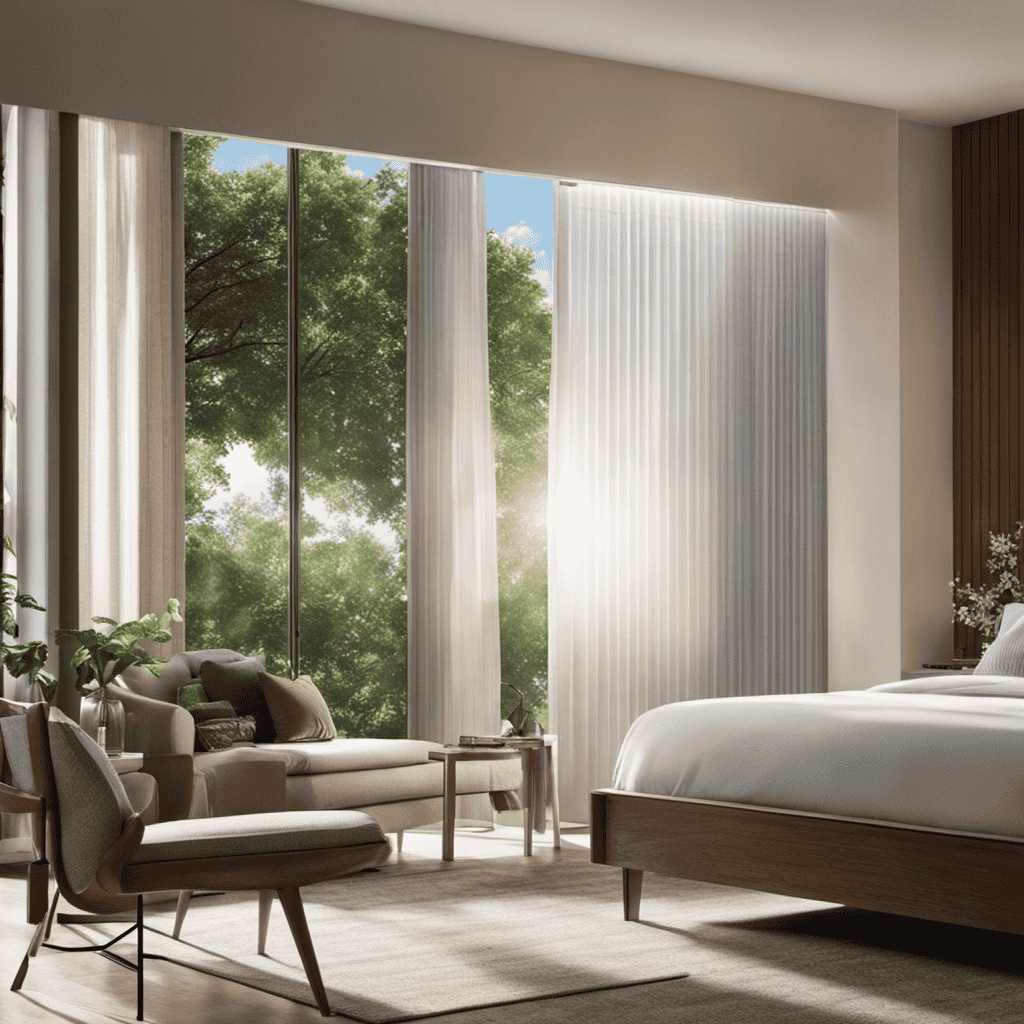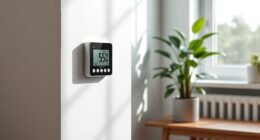Hey there! Have you ever wondered how often you should run your air purifier? Well, I’ve got all the answers for you.
As an environmental scientist specializing in indoor air quality, I’m here to provide you with comprehensive and evidence-based information on this topic.
We’ll dive into the benefits of running an air purifier regularly, factors to consider when determining usage frequency, and even how different seasons can affect your air quality.
So, let’s clear the air and get started on finding the perfect balance for your air purifier usage!
You should run your air purifier regularly because it helps to remove allergens and improve the air quality in your home. Room ventilation plays a crucial role in maintaining good indoor air quality. However, simply opening windows may not be sufficient, especially in areas with high pollution or during allergy seasons. This is where air purifiers come in. They work by circulating the air in a room through filters that capture particles such as dust, pollen, pet dander, and mold spores. These filters are designed to trap even the smallest particles, improving the overall air quality.
Regular use of an air purifier can provide several benefits. Firstly, it can help reduce allergy symptoms by removing allergens from the air. This is particularly important for individuals with respiratory conditions such as asthma or allergies. Secondly, air purifiers can help eliminate unpleasant odors, such as smoke or cooking smells, improving the overall indoor environment. Additionally, they can also reduce the presence of airborne viruses and bacteria, contributing to a healthier living space.
To ensure the effectiveness of an air purifier, it is crucial to maintain and clean the filters regularly. Air purifier filters should be replaced as recommended by the manufacturer or when they become visibly dirty. Neglecting filter maintenance can decrease the efficiency of the air purifier and potentially lead to the release of captured particles back into the air. Therefore, it is essential to follow the manufacturer’s instructions for proper filter care and replacement.
It is important to note that these recommendations are general guidelines and may vary depending on individual circumstances. Consulting with a healthcare professional or indoor air quality specialist can provide personalized recommendations for optimal usage of an air purifier.
When it comes to running an air purifier, determining the optimal running time is crucial.
Extended use of an air purifier can have both positive and negative impacts on indoor air quality.
As an environmental scientist, I will provide a thorough analysis of the benefits and drawbacks of extended use, relying on scientific research and data to support my claims and recommendations.
As you can see, certain lifestyle habits require more frequent use of air purifiers to maintain good indoor air quality. For example, if you smoke or have pets, running the air purifier continuously is recommended to effectively remove pollutants and pet dander from the air. On the other hand, if you only cook occasionally or have mild allergies, running the air purifier for a few hours a day may be sufficient.
Key Takeaways
- Running an air purifier regularly removes allergens, improves air quality, and reduces allergy symptoms and respiratory conditions.
- Factors to consider when determining usage frequency include room size, types of pollutants, indoor air quality goals, individual health conditions, and manufacturer’s instructions.
- Room size and types of pollutants impact air purifier effectiveness, and understanding pollutant types helps determine usage frequency.
- Clean air indoors is essential for individuals with allergies or respiratory conditions, and the severity of allergies or respiratory conditions affects usage frequency.
Benefits of Running an Air Purifier Regularly
Factors to Consider When Determining Usage Frequency
When it comes to determining the usage frequency of an air purifier, two important factors to consider are the size of the room and the pollutants present. Room size plays a crucial role in determining the effectiveness of an air purifier. Larger rooms may require a higher air exchange rate to effectively remove pollutants. Additionally, individual health conditions should be taken into account. Certain health conditions may require a higher level of air purification to maintain optimal indoor air quality.Room Size and Pollutants
Determining the size of your room and the pollutants present will help you decide how often to run your air purifier. It is important to consider the following factors when determining usage frequency:- Room size considerations: The size of your room will directly impact the effectiveness of your air purifier. Larger rooms may require longer running times or multiple units to adequately clean the air.
- Types of pollutants: Different air purifiers target specific pollutants such as dust, pollen, pet dander, or smoke. Understanding the types of pollutants present in your environment will help you choose the most suitable air purifier and determine how often it should be run.
- Indoor air quality goals: Your desired level of air purity will also influence the frequency of running your air purifier. If you have allergies or respiratory conditions, you may need to run it more frequently to maintain clean and healthy indoor air.
Individual Health Conditions
Understanding individual health conditions is crucial in determining the appropriate frequency for running an air purifier. For those managing allergies or respiratory conditions, having clean air indoors is essential for their well-being. Air purifiers can help reduce airborne allergens and pollutants, providing relief and improving indoor air quality. However, it is important to consider the specific needs of each individual when determining how often to run an air purifier. Factors such as the severity of allergies or respiratory conditions, the presence of other indoor pollutants, and the size of the room should be taken into account. In order to provide a comprehensive understanding, I have created a table below that outlines the recommended frequency for running an air purifier based on different health conditions.| Health Condition | Recommended Frequency |
|---|---|
| Mild Allergies | 4-6 hours daily |
| Severe Allergies | 8-10 hours daily |
| Asthma | 8-10 hours daily |
| COPD | 8-10 hours daily |
| Respiratory Infections | 24/7 operation |
Recommended Duration for Running an Air Purifier
Optimal Running Time
To get the most out of your air purifier, you should consider how long you typically spend in the room and adjust the running time accordingly. Here are some important factors to consider:- Recommended duration: It is generally recommended to run your air purifier for at least 8 hours a day to effectively clean the air in your room. However, if you spend more time indoors or if you have specific health considerations, you may need to run it for longer periods.
- Health considerations: Air purifiers can be particularly beneficial for individuals with allergies or respiratory conditions such as asthma. Running the purifier for longer durations can help remove harmful particles from the air, reducing the risk of respiratory symptoms and improving overall air quality.
- Noise level: Some air purifiers can be noisy, especially when running at higher speeds. It is important to consider the noise level and adjust the running time accordingly, especially if you plan to use the purifier in a bedroom or office where quietness is crucial.
Impact of Extended Use?
Extended use of an air purifier can have both positive and negative impacts. On the positive side, running the air purifier for extended periods can help maintain a consistently clean indoor air environment, ensuring that harmful pollutants are continuously filtered out. This can be particularly beneficial for individuals with respiratory conditions or allergies, as it reduces their exposure to triggers and improves overall air quality. However, it is important to note that prolonged use of an air purifier may also lead to certain health effects. For example, excessive exposure to ozone, a byproduct of some air purifiers, can irritate the respiratory system and worsen existing respiratory conditions. Additionally, if the air purifier is not properly maintained, it may become a breeding ground for mold and bacteria, potentially exacerbating allergies and respiratory issues. Therefore, it is crucial to strike a balance and consider the potential drawbacks of extended use while reaping the benefits of cleaner air. Transitioning to the next section, let’s now discuss how often you should run an air purifier in different seasons.How Often Should You Run an Air Purifier in Different Seasons
In different seasons, it’s important to consider how often you should run an air purifier. As an environmental scientist specializing in indoor air quality, I can provide you with some thorough tips for improving your indoor air quality through air purifier maintenance. Here are three key factors to consider:- Seasonal Changes: Different seasons bring different air quality challenges. For example, during spring, air purifiers can help remove allergens like pollen from the air. In the summer, they can help filter out pollutants from outdoor wildfires or smog. In the winter, air purifiers can reduce indoor air pollution caused by heating systems and closed windows.
- Room Size and Occupancy: The size of the room and the number of people in it will impact the frequency at which you should run your air purifier. Larger rooms or rooms with more occupants may require more frequent usage to maintain air quality.
- Sensitivity to Indoor Air Pollutants: If you or someone in your household suffers from allergies, asthma, or other respiratory conditions, it may be beneficial to run the air purifier more often to minimize exposure to potential triggers.
Understanding the Air Quality in Your Home
When it comes to understanding the air quality in your home, it’s important to consider the sources of indoor air pollution and how to effectively monitor it. Indoor air pollution can come from various sources such as tobacco smoke, household cleaning products, and even pet dander.Indoor Air Pollution Sources
You should be aware of the various sources of indoor air pollution. Indoor air pollution can come from a variety of sources, some of which you may not even realize. Here are three common sources of indoor air pollution that you should keep in mind:- Chemicals: Household cleaning products, paints, and even furniture can release harmful chemicals into the air.
- Biological pollutants: Mold, pollen, pet dander, and dust mites can all contribute to poor indoor air quality.
- Combustion byproducts: Gas stoves, fireplaces, and tobacco smoke all release pollutants into the air.
Monitoring Air Quality
To effectively monitor the quality of the air in your home, it’s important to regularly check for potential sources of indoor air pollution. As an environmental scientist, I understand the significance of maintaining clean and healthy indoor air. One effective way to improve indoor air quality is by using air purifiers. These devices can help remove allergens, such as dust, pollen, and pet dander, from the air, providing relief for individuals with allergies and respiratory conditions. Air purifiers work by trapping these particles in filters, preventing them from circulating in your home. However, it’s essential to note that air purifiers may have some drawbacks, such as the need for regular filter replacements and the potential for increased energy consumption. Therefore, it’s crucial to choose a high-quality air purifier and consider factors such as room size and the specific pollutants you want to target. Regular air quality testing is also important to ensure the effectiveness of the air purifier and to identify any additional sources of indoor air pollution.Signs That Indicate the Need for Increased Air Purifier Usage
There’s no denying that if you’re experiencing frequent allergies or respiratory symptoms, it may be time to use your air purifier more often. As an environmental scientist specializing in indoor air quality, I understand the importance of maintaining clean air in our homes. Here are three signs that indicate the need for increased air purifier usage:- Persistent Allergies: If your allergies have worsened recently or if you find yourself sneezing and coughing more frequently, it could be a sign that the air in your home is contaminated with allergens such as dust mites, pollen, or pet dander.
- Respiratory Issues: Wheezing, shortness of breath, or tightness in the chest are all symptoms that suggest poor air quality. Air purifiers can help remove harmful particles and improve indoor air quality, reducing the risk of respiratory issues.
- Lingering Odors: If you notice unpleasant odors that persist even after thorough cleaning, it could be a sign that your air purifier needs to run more often. Air purifiers with activated carbon filters can effectively remove odors from cooking, pets, or tobacco smoke.
How to Maximize the Efficiency of Your Air Purifier
Running your air purifier continuously and placing it in a central location can help maximize its efficiency in improving indoor air quality. As an environmental scientist specializing in indoor air quality, I have extensively researched the benefits and potential drawbacks of air purifiers. Scientific studies have shown that air purifiers can effectively remove various pollutants from the air, including dust, pollen, pet dander, and harmful particles. By continuously running your air purifier, you ensure that it consistently filters and cleans the air, creating a healthier environment for you and your family. To maximize the efficiency of your air purifier, it is important to consider the recommended frequency of filter replacement. Most air purifiers come with specific guidelines on when to replace the filters, usually every 3-6 months. Regular filter replacements ensure that the purifier continues to function optimally and effectively remove pollutants from the air. Additionally, it is important to consider the size of the room where the air purifier is placed. Air purifiers are designed to clean the air in a specific square footage range. Placing a purifier in a room that exceeds its recommended coverage area may result in reduced efficiency. Therefore, it is essential to adjust the usage of your air purifier based on the size of the room to ensure maximum effectiveness. In summary, running your air purifier continuously, replacing filters as recommended, and considering room size can help maximize the efficiency of your air purifier and improve indoor air quality. By following these suggestions, you can create a healthier and safer living environment for yourself and your loved ones. Transition: Now that we have discussed how to maximize the efficiency of your air purifier, let’s move on to the next section: adjusting air purifier usage based on room size.Adjusting Air Purifier Usage Based on Room Size
When adjusting the usage of your air purifier based on the size of the room, it’s important to consider the recommended square footage range for optimal effectiveness. Adjusting the settings and placement of your air purifier can significantly impact its performance. Here are three key factors to consider:- Room Size: The size of the room is a crucial factor in determining the effectiveness of your air purifier. Larger rooms require more powerful purifiers or additional units to cover the entire space effectively.
- Airflow Capacity: Air purifiers have different airflow capacities, which determine how much air they can filter within a given time. It’s important to choose a purifier with a capacity that matches the size of your room to ensure efficient air purification.
- Placement: Proper placement of your air purifier is essential for maximizing its effectiveness. It’s recommended to place the purifier in a central location within the room, away from obstructions such as furniture or curtains, to allow for better air circulation.
The Impact of Lifestyle Choices on Air Purifier Usage Frequency
It’s essential to consider the impact of lifestyle choices on how frequently you use an air purifier. Our lifestyle habits can greatly affect the air quality in our homes, which in turn affects the effectiveness of air purifiers. To help you understand this relationship better, let’s look at some common lifestyle habits and their impact on air purifier usage frequency.| Lifestyle Habit | Impact on Air Quality | Recommended Air Purifier Usage Frequency |
|---|---|---|
| Smoking | Increases pollutants | High (24/7 if possible) |
| Pet Ownership | Pet dander and odors | Medium to High (8-12 hours/day) |
| Cooking | Releases cooking fumes | Medium (4-6 hours/day) |
| Allergies/Asthma | Triggers allergens | High (24/7 if possible) |
| Open Windows/Doors | Pollutants from outside | High (24/7 if possible) |
Ensuring Proper Maintenance for Optimal Air Purifier Performance
To maintain optimal performance, you’ll want to regularly clean and replace the filters in your air purifier. This simple maintenance task is crucial for maximizing the lifespan of your air purifier and ensuring that it continues to effectively clean your indoor air. Here are three important aspects to consider when it comes to maintaining your air purifier:- Cleaning the filters: Over time, the filters in your air purifier can become clogged with particles and pollutants. Regularly cleaning or replacing these filters is essential for maintaining the efficiency of your air purifier. It is recommended to clean or replace the filters every 3 to 6 months, depending on the manufacturer’s instructions.
- Checking for airflow obstructions: It’s important to regularly check for any obstructions that may hinder the airflow in your air purifier. Dust or debris buildup on the unit or near the vents can restrict the air circulation, affecting the performance of the purifier. Regularly cleaning the exterior of the unit and ensuring that there are no objects blocking the vents will help maintain optimal airflow.
- Troubleshooting common issues: Air purifiers, like any other electronic device, may experience common issues such as strange odors, unusual noises, or reduced efficiency. Troubleshooting these issues promptly can help identify and resolve any underlying problems, ensuring that your air purifier functions properly.
Balancing Energy Consumption and Air Purification Needs
Finding the right balance between energy consumption and maintaining effective air purification is essential for optimizing the performance of your air purifier. As an environmental scientist specializing in indoor air quality, I understand the importance of using your air purifier efficiently while still achieving clean and healthy air in your home. To help you strike that balance, here are some energy-saving tips and air purifier maintenance recommendations:| Energy-Saving Tips | Air Purifier Maintenance | Factors to Consider |
|---|---|---|
| Adjust fan speed to a lower setting, if possible | Regularly clean or replace filters | Room size and air quality |
| Use a timer to schedule air purifier operation | Clean the exterior and vents regularly | Allergies or specific air quality concerns |
| Keep windows and doors closed during operation | Check for any leaks or malfunctions | Noise level and energy consumption |
| Place the air purifier strategically for maximum effectiveness | Monitor the air quality and adjust usage accordingly | Budget for energy costs and filter replacements |
| Consider investing in an energy-efficient model | Follow manufacturer’s instructions and recommendations |
Is There a Recommended Frequency for Running an Air Purifier?
The frequency of running an air purifier depends on factors such as room size, air quality, and personal preferences. Typically, it is advised to run an air purifier for a minimum of 8 hours per day. However, in highly polluted areas or for people with allergies, running it continuously could be more advantageous.










